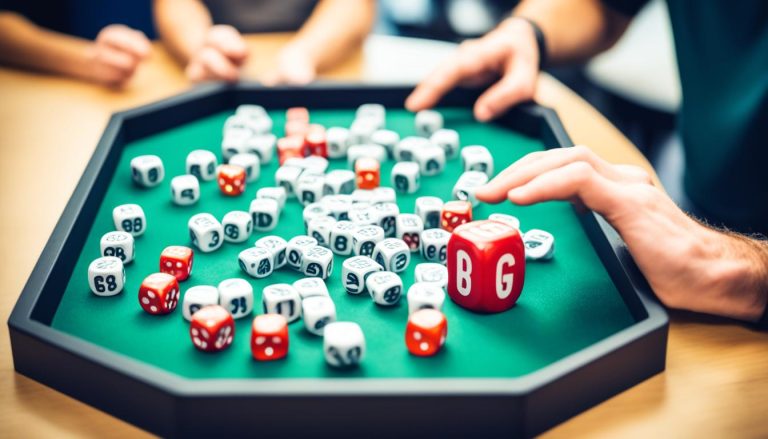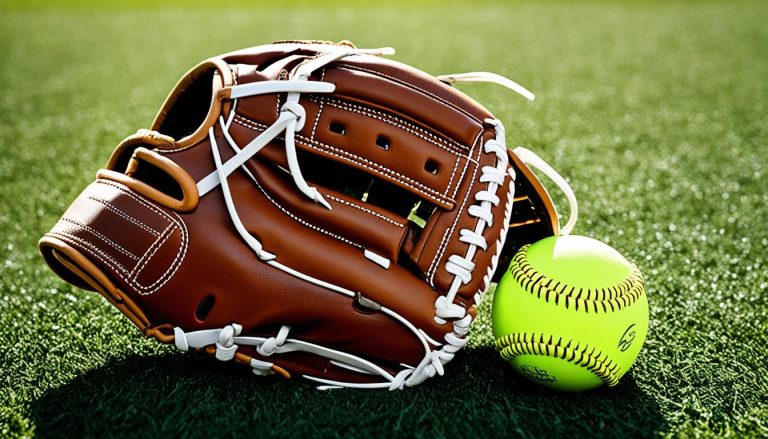Welcome to our beginner’s guide on how to play pool! Whether you’re a complete novice or looking to improve your skills, we’ll provide you with essential tips and techniques to enhance your pool game. From perfecting your grip and stance to mastering the art of aiming and angles, we’ve got you covered. So, let’s dive in and discover the secrets to becoming a pool pro!
How to Play Pool?
First and foremost, let’s start with the basics. To improve your pool game, it’s crucial to develop a loose grip on the pool cue. Many beginners make the mistake of gripping the cue too tightly, which makes it difficult to control the cue ball and make accurate shots. Practice holding the cue with a relaxed grip, resting it on your fingers instead of squeezing it tightly. This will give you better control and maneuverability.
Next, let’s focus on your stance. A proper pool stance is essential for stability and accuracy. Start by positioning your dominant hand’s foot about two feet behind your non-dominant hand’s foot, creating a 90-degree angle with your arm. This will provide you with a solid base and proper alignment, ensuring consistent and accurate shots.
Aiming is a critical aspect of playing pool. Two effective techniques to improve your aim are the shot line and point of contact. The shot line is the imaginary line that runs through the cue ball and continues toward the object ball you want to hit. Visualize this line and align your shots accordingly. The point of contact refers to the specific spot on the object ball that you need to strike with the cue ball to make it go in your desired direction. Mastering these techniques will greatly enhance your accuracy.
Developing Your Pool Swing and Bridges
Once you have mastered the fundamentals of pool, it’s time to take your game to the next level by focusing on developing your pool swing and bridges. These aspects of your technique can greatly enhance your control, accuracy, and overall performance on the table.
Practice Your Pool Swing
A crucial element of a successful pool technique is mastering your pool swing. Imagine your cue as a pendulum, swinging back and forth in a smooth and steady motion. This pendulum motion allows you to maintain control and precision throughout your shots.
When you swing forward, pay close attention to the speed and momentum of your swing. Adjusting these factors can help you control the speed and distance of the cue ball. Practice swinging the cue at different speeds to develop a feel for different shot scenarios. This will enable you to adjust your swing accordingly during actual gameplay.
Explore Different Pool Bridges
Bridges serve as a support system for your cue hand, providing stability and control during your shots. There are various types of bridges to consider, each with its own advantages and applications.
- Open Bridge: This bridge involves loosely spreading your fingers on the table and using your thumb as a guide. It allows for more flexibility and adaptability when executing different shots.
- Closed Bridge: For increased stability and precision, try the closed bridge. This involves resting the base of your palm on the table while placing your fingertips on the felt, forming a stable platform for your cue.
- Elevated Bridge: When a ball obstructs a smooth stroke, the elevated bridge comes to the rescue. By raising your cue higher than usual and using your fingers as support, you can navigate obstacles and execute shots with ease.
- Rail Bridge: This bridge is handy when your desired shot requires you to aim close to the rail. Simply rest your cue on the rail itself to stabilize your shot and maintain greater accuracy.
- Mechanical Bridge: Also known as the “cue rest” or “spider,” the mechanical bridge is a handy tool for those hard-to-reach shots. It allows you to extend your reach with the support of a bridge head attached to the end of your cue.
By practicing and utilizing these different pool bridges, you can enhance your stability, control, and shot-making abilities in various game situations.
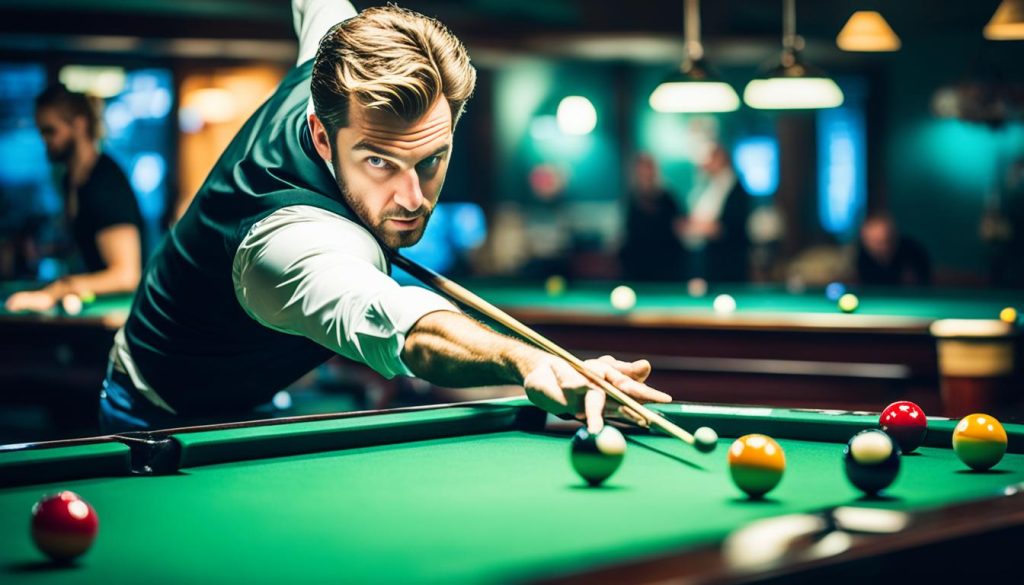
Practicing your pool swing and becoming familiar with different pool bridges will take your game to new heights. Make it a habit to spend time refining these aspects of your technique, and you will see your control and accuracy improve over time.
Mastering Pool Break and Ball Control
The break shot in pool is a crucial aspect of the game that can give you an immediate advantage by pocketing at least one ball. To improve your break technique, it’s important to focus on adjusting the speed and power of your shot to find the right combination that allows you to pocket balls consistently.
Tip: Experiment with different break speeds and observe how the cue ball reacts with the racked balls. Take note of the results and analyze how minor adjustments in power can produce different outcomes.
In addition to mastering the break, developing cue ball control is essential for progressing in pool. Cue ball control refers to the ability to make precise shots and position the cue ball for future shots. This skill allows you to strategically set up your next moves and control the flow of the game.
Pool Strategies for Cue Ball Control:
- Positional Aiming: Focus on aiming at a specific spot on the object ball, aiming to hit it at the desired angle to control the cue ball’s positioning for your next shot.
- Speed Control: Pay attention to the speed at which you strike the object ball with the cue ball. Varying the speed can help you position the cue ball accurately for your next move.
- Planning Ahead: Anticipate your next shots and plan your cue ball positioning accordingly. Consider the angles, potential rebounds, and obstacles on the table to set up favorable shots.
Tip: Practicing cue ball control drills, such as position play and speed control exercises, can sharpen your skills and improve your ability to control the flow of the game.
Mastering pool break and ball control requires practice, observation, and strategic thinking. By developing your break technique and cue ball control skills, you’ll enhance your ability to pocket balls consistently and execute effective strategies during gameplay.
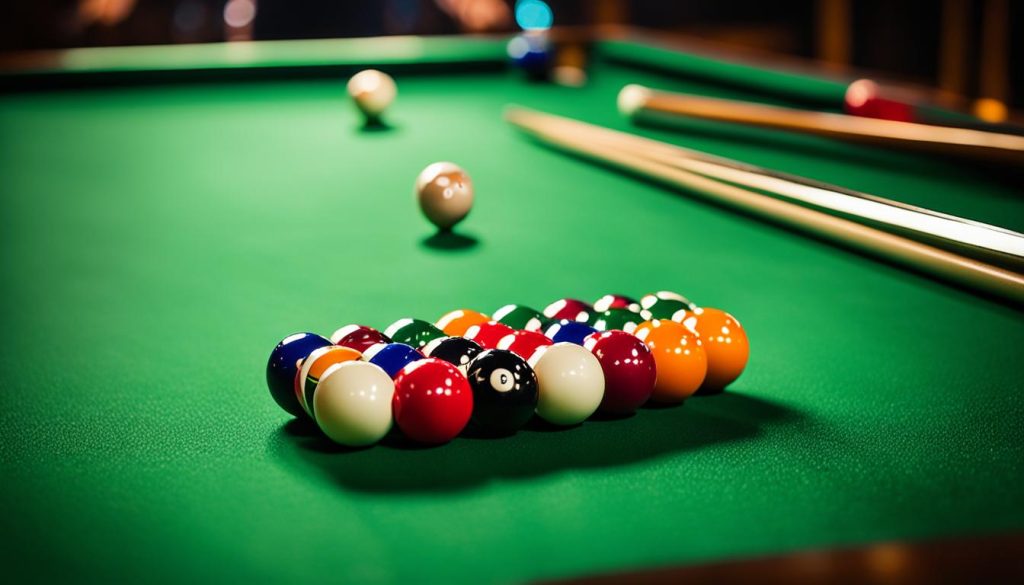
Perfecting Your Pool Aiming and Angles
Aiming and understanding angles in pool are fundamental to becoming a skilled player. To improve your aim, it is important to practice visualizing and aligning your shots to accurately target the object ball and pocket.
One technique that can help you determine the angle of contact is the “ghost ball” method. Imagine an invisible ball next to the ball you want to hit, and aim to strike that imaginary ball with the cue ball. This technique helps you visualize the correct angle for a successful shot.
Developing an understanding of how angles work in bank shots and kick shots is also essential. Bank shots involve bouncing the cue ball off the cushion to make a difficult shot or redirect the ball towards the intended pocket. Kick shots require hitting the cue ball into an object ball indirectly, using the cushion as a rebound to pocket the target ball.
Furthermore, knowing how to use the cue ball to strike multiple balls in the desired direction can give you an advantage in the game. By carefully considering the angle at which the cue ball strikes the first ball, you can create a chain reaction, causing other balls to move and potentially pocketing multiple balls in a single shot.
Another helpful tip is to view shots from different perspectives. Changing your viewpoint around the table can provide alternative angles and make it easier to select the right shot. Take your time to analyze the table and consider the best possible angles for each shot.
Remember, perfecting your aiming and angles in pool requires practice and experience. By honing your skills in visualizing shots, understanding angles, and utilizing the cue ball strategically, you can elevate your gameplay to new heights.
Summary:
- Practice visualizing and aligning shots for accurate aim.
- Use the “ghost ball” method to determine angle of contact.
- Understand angles in bank shots and kick shots.
- Utilize the cue ball to strike multiple balls in the desired direction.
- View shots from different perspectives for improved shot selection.
Enhancing Post-Shot Follow-Through and Analysis
Many beginners have a tendency to stand up immediately after hitting the cue ball, which can impact the follow-through and analysis of the shot. To improve your pool skills and gain better control over your shots, it is essential to work on enhancing your post-shot follow-through.
After striking the cue ball, make a conscious effort to maintain your position and keep your cue stick in contact with the table. This position allows you to observe and analyze the movement of the balls and evaluate the outcome of your shot. The post-shot follow-through helps you understand the effect of your shot and make necessary adjustments to improve your skills.
By focusing on your post-shot follow-through, you can gather valuable information about the speed, spin, and accuracy of your shots. This analysis enables you to identify areas for improvement and develop strategies for future shots. Furthermore, it reinforces muscle memory and consistency in your playing technique.
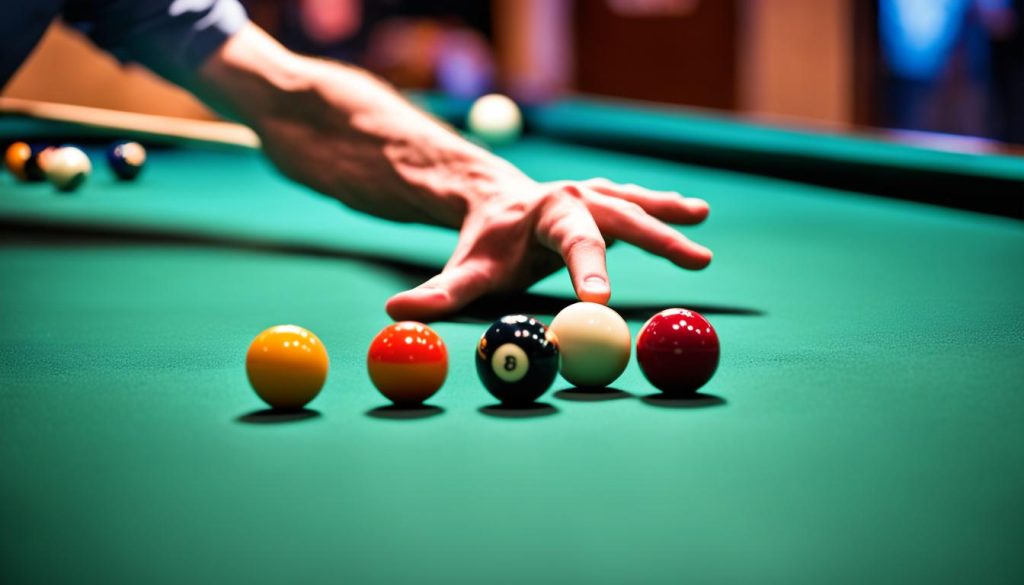
Implement these pool playing tips to enhance your post-shot follow-through and analysis:
- Keep your eyes on the cue ball and observe its interaction with the object ball(s).
- Focus on the path of the cue ball after the shot and evaluate its accuracy.
- Take note of any unintended spin or unintended contact on the cue ball.
- Analyze the final position of the object ball(s) and assess if it aligns with your intended shot.
- Use the information gathered from your follow-through analysis to refine your playing strategies and adjust your shot selection.
By diligently practicing post-shot follow-through and analysis, you can fine-tune your technique, improve your pool skills, and elevate your overall performance on the table.
Choosing the Right Pool Cue and Equipment
Having the right pool cue and equipment is essential for enhancing your playing experience and improving your skills. When selecting a pool cue, consider several factors that can greatly impact your performance on the table.
Cue Grip
One of the most critical aspects of a pool cue is the grip. The grip determines how the cue feels in your hands and affects your control over the cue ball. Experiment with cues that have different grip materials, such as leather or rubber, to find the one that suits your preference and provides a comfortable yet secure grip.
Weight and Length
The weight and length of a pool cue are crucial factors in finding the right cue for your game. Lighter cues may provide more finesse and control, while heavier cues can offer more power in shots. Similarly, the length of the cue can affect your stance and stroke mechanics. Test different cue weights and lengths to discover the combination that feels natural and allows you to execute shots with ease.
Cue Tip
The cue tip plays a vital role in how the cue interacts with the cue ball. Different cue tips can offer varying levels of control and spin. Consider the hardness of the cue tip, with softer tips allowing for more grip on the cue ball and harder tips providing a crisper contact. Experiment with different cue tip hardnesses to find the one that suits your playing style and desired shot outcomes.
Aside from the pool cue, investing in quality equipment can enhance your overall playing experience. Here are a few essential items to consider:
- Pool Tables: Ensure you have access to a high-quality pool table that is well-maintained and levelled. Playing on a subpar table can significantly affect your shots and gameplay.
- Chalk: Properly chalked cue tips minimize slippage and provide better control over the cue ball. Regularly chalk your cue to optimize your shots.
- Pool Accessories: Additional accessories like cue racks, bridge sticks, and protective cases can improve convenience and protect your cue when not in use.
Remember, choosing the right pool cue and equipment is a personal decision that depends on your playing style, preferences, and budget. Take the time to try out different cues and equipment to find the ones that feel comfortable and enhance your gameplay.
| Factors to Consider | Impact on Gameplay |
|---|---|
| Cue Grip | Affects control over the cue ball |
| Weight and Length | Influences shot power and stroke mechanics |
| Cue Tip | Determines contact and spin on the cue ball |
Conclusion
By following these tips and regularly practising, you can elevate your pool game and become a more skilled player. Remember to focus on the fundamentals such as developing a loose grip, practising your stance and aim, and honing your swing and bridges. Additionally, mastering the art of breaking and cue ball control, understanding angles and shot selection, and maintaining consistency in your post-shot follow-through are essential for advanced pool strategies. Don’t forget to choose the right pool cue and equipment that suit your preferences and style.
With dedication and practice, you can confidently master the game of pool and enhance your skills to the next level. Enjoy the game, challenge yourself with mastering difficult shots, and continuously refine your advanced pool strategies. Remember, the more you play and improve, the more satisfying and exciting your pool experience will become. So pick up your cue, get on the table, and let your mastery of the game shine through!


